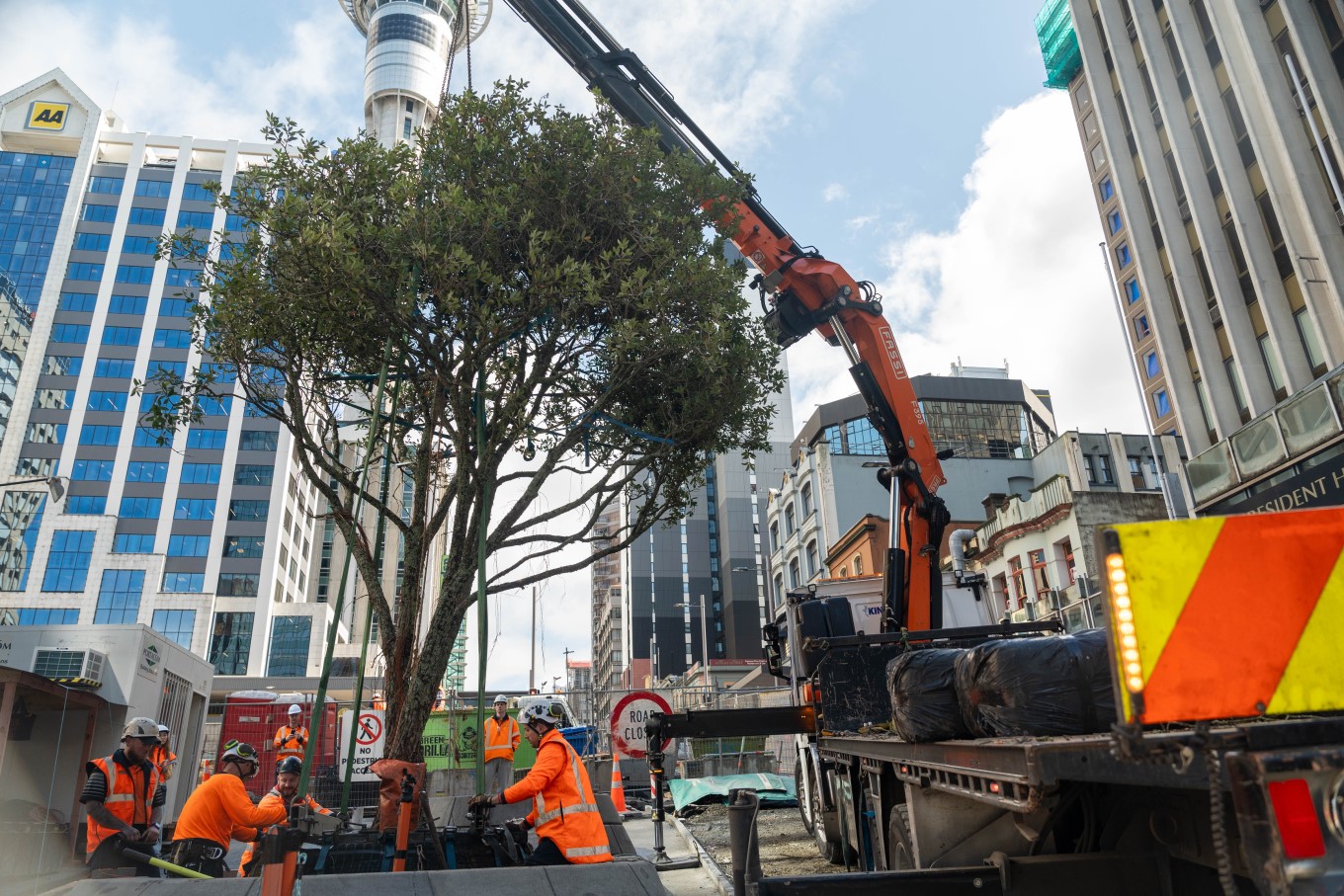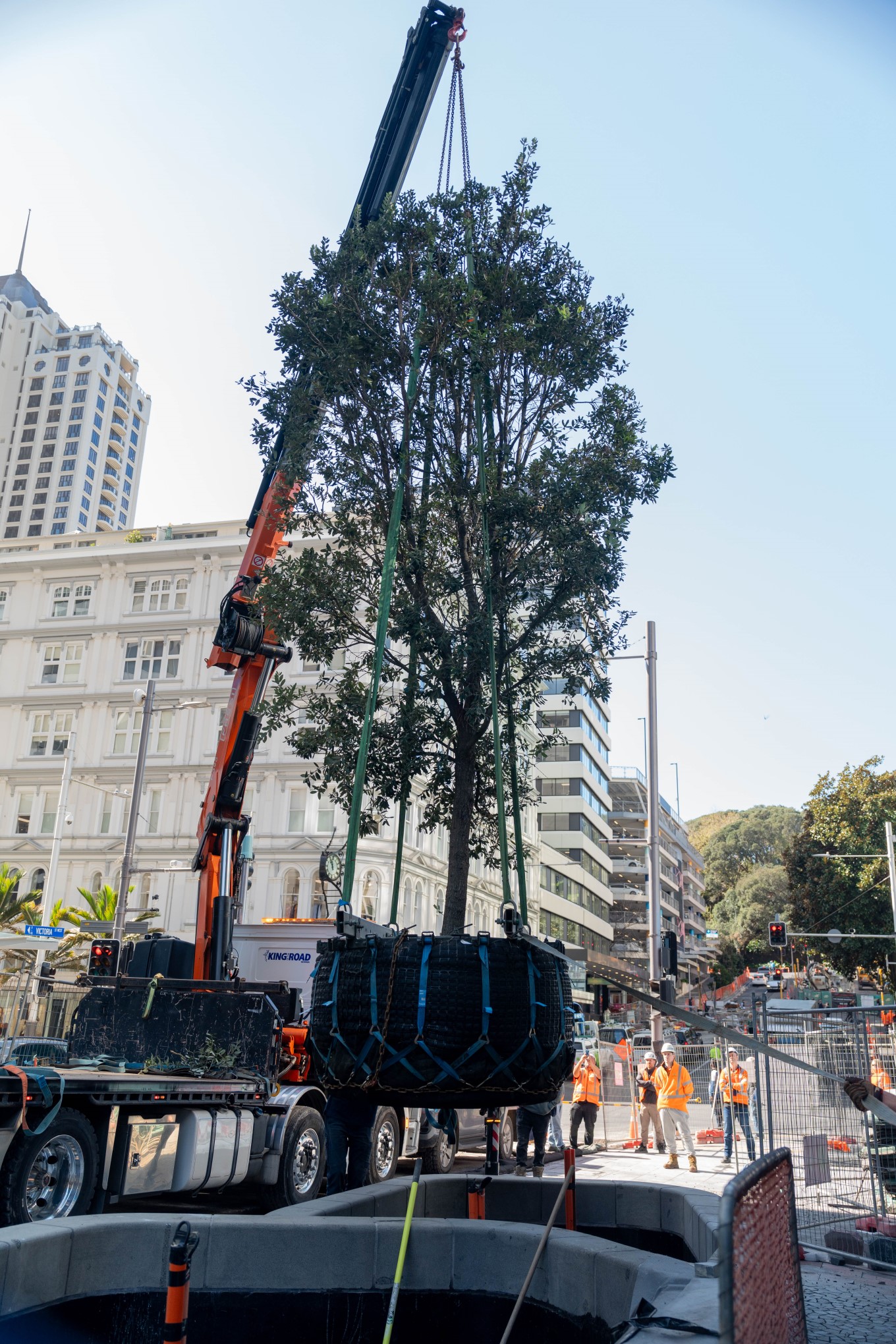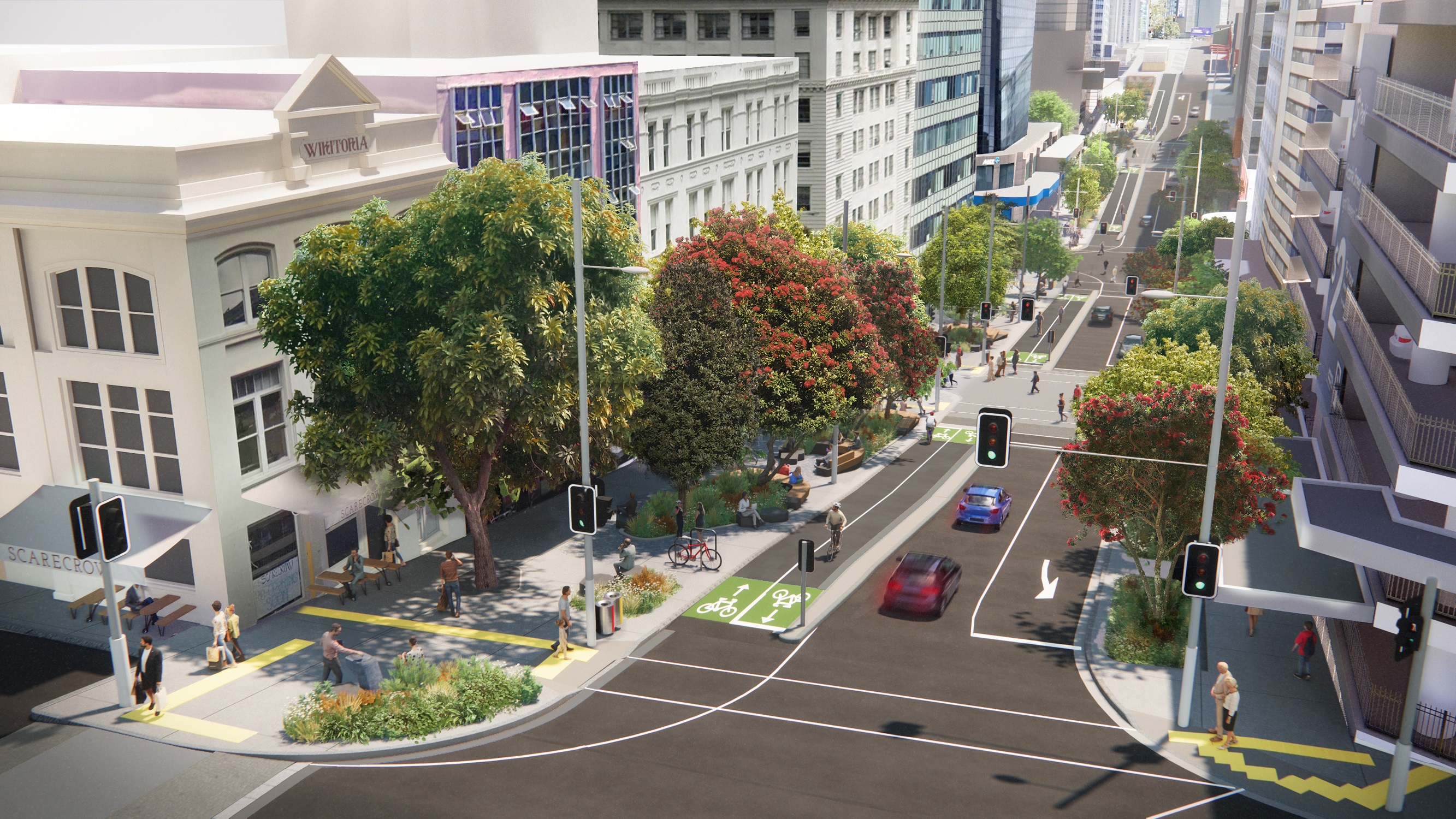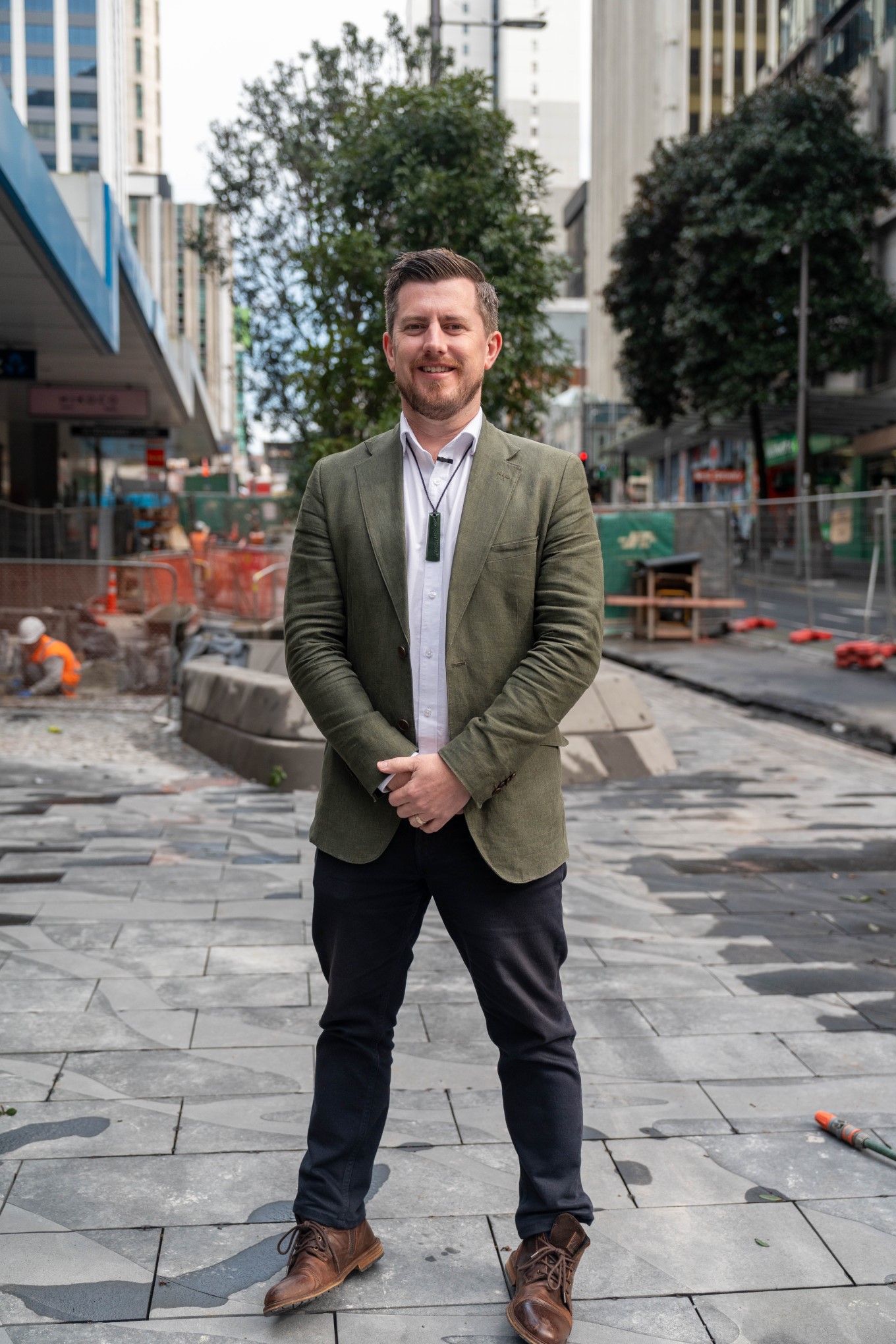Eleven trees - two close to five metres tall - have been crane-lifted into waiting tree pits in Victoria Street this week, marking another milestone in the emergence of Te Hā Noa.
The maturing trees selected for this project have been grown and nurtured in Auckland nurseries, some for more than a decade.
Te Hā Noa will be a high quality accessible public space, welcoming people who are arriving into Victoria Street from Te Waihorotiu Station from 2026.
The name Te Hā Noa was gifted by mana whenua, conveying thoughts about the freedom to breathe and enjoy the experience of the sights and sounds around you.
Mana whenua have also guided the terracing design of the tree pits, referencing the volcanic geology and forms of Tamaki Makaurau. Visitors will be able to sit on the natural stone terraces under the shade of native trees, with uplit foliage in the evenings. Widened footpaths will provide improved amenity for people enjoying the space.
The opening of this first stage of Te Hā Noa – from Elliott Street to Queen Street – is not far away. The project team anticipate this section to be publicly accessible from late October, with the second stage from Lorne Street to Albert Park opening around the end of summer.

People will see pōhutukawa, pūriri, taraire and tītoki greening the fringes of the redesigned street, with 900 plants creating understories beneath the canopies by the end of September. The 11 native trees are the first of 20 of varying sizes being planted by Auckland Council in Victoria Street.
Councillor Richard Hills is looking forward to seeing the trees arrive in Victoria Street this week.
“We see the massive benefits the great new trees on Quay St, Te Wānanga and Wynyard Quarter are making. Te Hā Noa will add to Auckland’s healthy and diverse network of green infrastructure, which is critical across the region,” he says.

Trees provide shade and shelter, attract birdlife, cool the city centre and absorb carbon. With hard concrete surfaces and heat from reflective glass high rises, it can be a challenge in an urban setting to create an environment where trees and vegetation thrive.
The tree pits for Te Hā Noa are designed to keep the trees safe from heavy equipment and vehicles and allow them to flourish. Some are also a sustainable part of the city’s stormwater drainage system. Surface rainwater from the road and paved surfaces is dispersed into the tree pits.
In time, Te Hā Noa will form a green link across the city, linking two city parks – Rangipuke / Albert Park and Waikōkota / Victoria Park.
The trees are another visual symbol of the step-change locals are seeing in the station neighbourhood. The trees arrive as the Auckland Council group announces the next series of construction milestones.
Complementary streets

Victoria Street is one of three east-west streets in the Te Waihorotiu Station neighbourhood undergoing a major transformation to create a new gateway for the city centre.
Before the regeneration of midtown, Victoria Street, Wellesley Street and Mayoral Drive were dense traffic routes carrying more than four lanes of cars, trucks and buses, with cyclists hugging the edges, pedestrians vying with scooters along narrow footpaths and a noisy environment for businesses.
The new station means thousands of people will arrive directly into midtown by train, boosting foot traffic for businesses in the area. The neighbourhood upgrade will see Wellesley Street become an important central city bus interchange, and the upgraded Victoria Street will make connecting between walking, cycling, high frequency bus routes, and the train station easier and safer.
Councillor Richard Hills says Aucklanders have a lot to look forward to once the delivery of these complex integrated works is complete. He says the area will flourish as a commercial, hospitality and residential community with Te Waihorotiu Station at its heart.
“I’m looking forward to our new streets and spaces, an underground rail network, better bus routes, billions of dollars of private sector investment in the area, and a thriving arts quarter, bordered by three beautiful city parks – Myers, Albert and Victoria.
“It’s great to see that residents and visitors can now walk on brand new pavement all the way along Albert Street to the waterfront. We are still working on big infrastructure upgrades in the city centre, but large areas of our new public realm are now complete,” Councillor Hills says.
Vision and delivery

Visionary urbanist Jane Jacob comments on the vital role public spaces play in the life of a city. “A city’s streets and their sidewalks - the main public places of a city - are its most vital organs,” she says.
Jenny Larking, Auckland Council Head of City Centre Programmes, echoes this sentiment when speaking about the station neighbourhood her team and the wider Auckland Council group are delivering in midtown.
“We recognise that beautiful public spaces encourage social interaction, creating a strong sense of community and belonging. These spaces become the stages where city life unfolds, memories are made, and a city’s identity is forged.
“We are creating streets and spaces that are authentic, safe, sustainable and reflective of our place in the world, with mana whenua-led expression woven throughout, while continuing to support the operations of a busy city centre.
“By 2026, this regeneration programme we’re leading will transform midtown. I am pleased we can encourage Aucklanders to come and see the first batch of trees we’ve planted for Te Hā Noa. There is a lot for everyone to look forward to,” she says.
Patrick Reynolds deputy chair of the City Centre Advisory Panel attended the tree-planting this week. He says the panel have been long-time champions of Te Hā Noa.
“The City Centre Advisory Panel are delighted to see these magnificent trees going in. We are particularly grateful to the expert team so carefully handling these big trees, and to the public and nearby businesses and residents for their patience through the works - it will be more than worth it,” he says.
Read about the multiple projects being co-ordinated in midtown here and the wide-ranging benefits of trees here.
Read more about the city centre’s transformation here.




